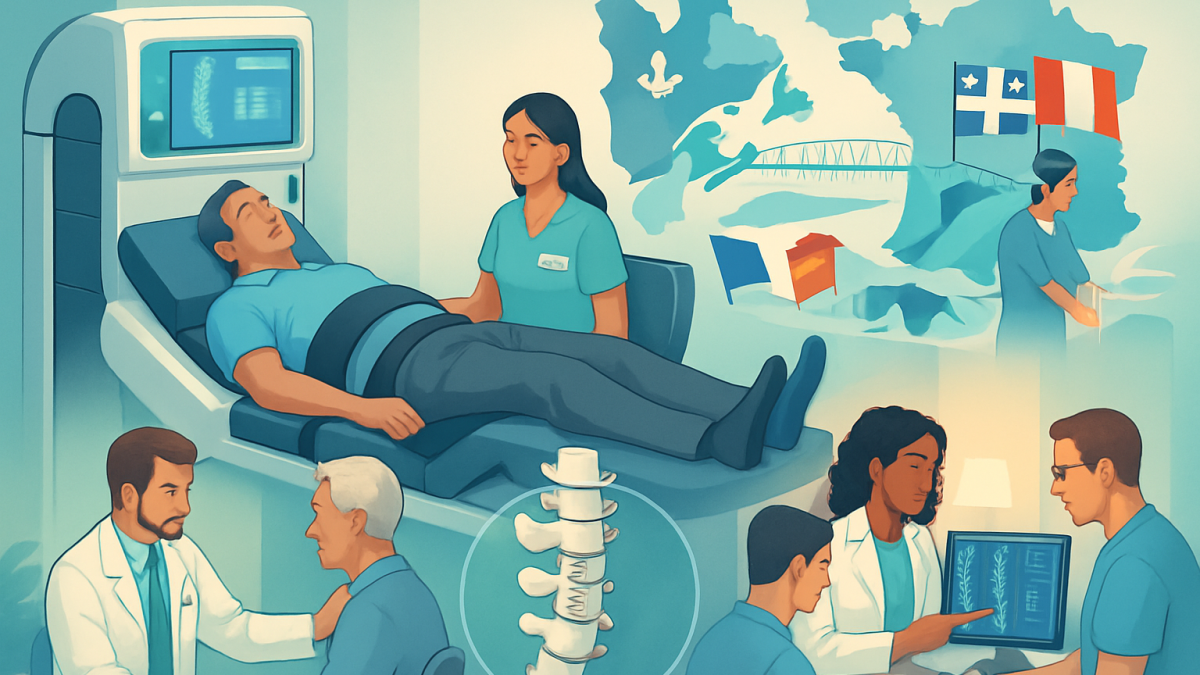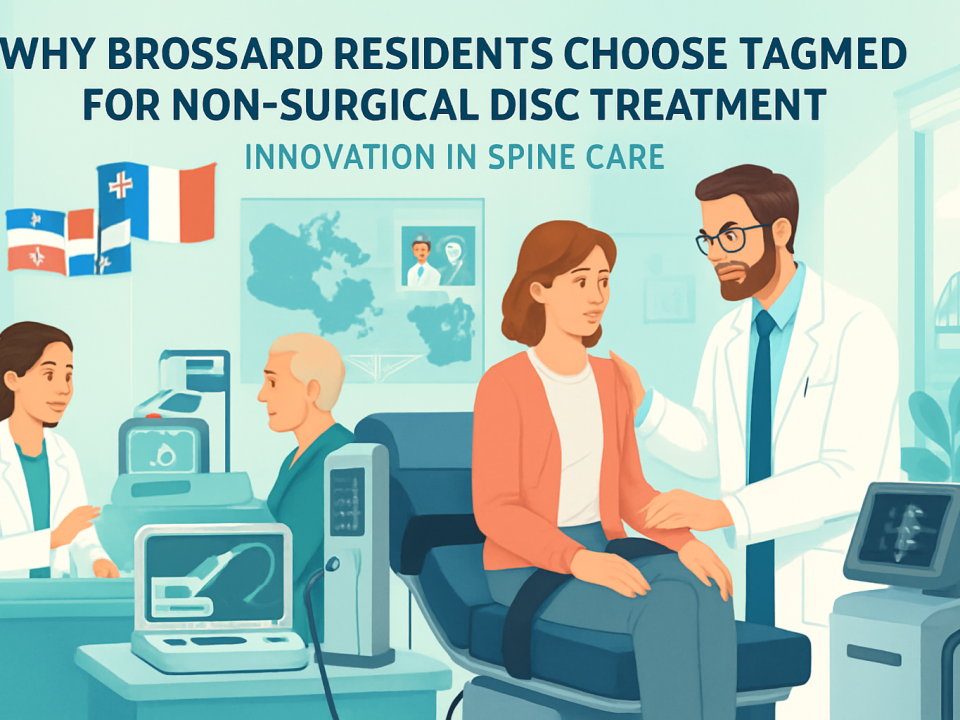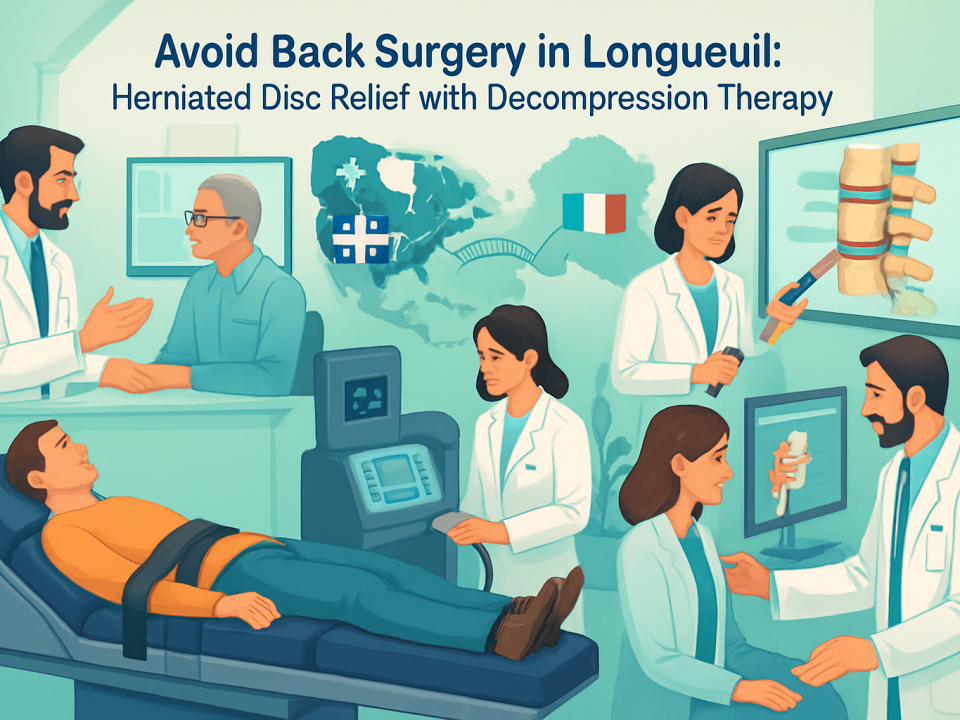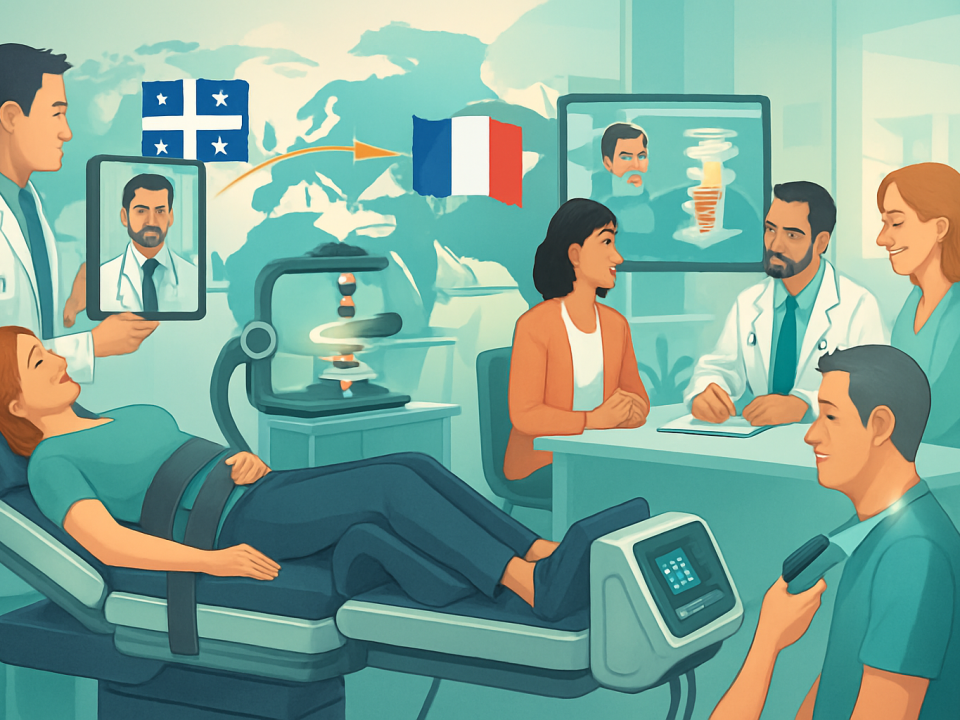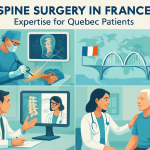
Spine Surgery in France: Expertise for Quebec Patients
August 15, 2025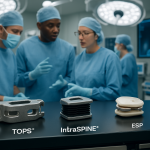
Innovative implants: exploring the impact of TOPS™, Intraspine®, and ESP on surgical decision-making
August 15, 2025Living with persistent back pain due to a herniated disc can drastically affect daily life. Many patients seek relief through the latest technologies and expert care, balancing effectiveness with safety and comfort. In Montreal, non-surgical spinal decompression has emerged as a leading therapy offering this balance, particularly through the expertise and compassionate approach of Dr. Sylvain Desforges, one of Canada’s foremost spine care experts. With more than 30 years of clinical experience and a commitment to innovation and evidence-based practice, Dr. Desforges has positioned himself at the forefront of non-invasive spinal treatments.
This comprehensive guide dives deep into the world of non-surgical spinal decompression therapy for herniated discs, highlighting its mechanisms, benefits, patient preparation, and recovery pathways. Patients and healthcare professionals alike will find clear explanations clarifying when and how this therapy is appropriate, avoiding unnecessary jargon while underscoring the rigorous standards adhered to by experts such as Dr. Desforges. Moreover, the guide includes the pivotal role of modern clinics like the Montreal Spine Clinic and technologies such as SpineMed, DRX9000, and VAX-D, reinforcing the growing ecosystem of spine care in Quebec and beyond.
Understanding the nuanced decisions behind spinal decompression — comparing it thoroughly with surgical alternatives and integrating insights from trusted institutions like the Canadian Spine Institute and ChiroMontreal — empowers patients with real options grounded in integrity and science. This article also uncovers the innovative avenues of international collaboration that enhance patient outcomes, including Dr. Desforges’ partnerships with leading French spine surgeons facilitated through SOS Tourisme Médical.
As you navigate this terrain of spinal care, expect not only to learn about successful treatments but also about personalized care journeys tailored to your unique condition. The clinic’s patient-first philosophy echoes throughout, promising you support toward improved mobility, pain relief, and lasting recovery.
How Non-Surgical Spinal Decompression Therapy Works for Herniated Discs in Montreal
Non-surgical spinal decompression therapy is an advanced, evidence-informed technique that gently stretches the spine to alleviate pressure on herniated or bulging discs. This treatment promotes natural healing by creating negative pressure within the affected disc, encouraging the retraction of protruding material away from nerve roots.
Mechanism of Action
The therapy uses computer-controlled motorized traction tables, such as models by SpineMed and DRX9000, customized to each patient’s specific spinal measurements and condition severity. By intermittently stretching and relaxing the spine, the therapy reduces intradiscal pressure, facilitating the migration of water, oxygen, and nutrient-rich fluids into the disc space to stimulate healing. Unlike traditional traction methods, this approach is precise and avoids muscle guarding, which can otherwise undermine treatment.
Institutions like the Spine Together Clinic and the Acibadem Health Group have demonstrated positive outcomes using such protocols. However, the success of decompression depends on proper patient selection, treatment adherence, and supportive care.
Key Benefits of Non-Surgical Spinal Decompression
- Non-invasiveness: The therapy avoids the risks of surgery, such as infection or anesthesia complications.
- Pain Relief: By decompressing nerves irritated by herniated discs, patients frequently report significant reductions in back and leg pain.
- Improved Mobility: Reduced nerve compression allows better movement and function.
- Promotion of Healing: Increased nutrient flow encourages disc repair and overall spinal health enhancement.
- Absence of Medication Dependency: This method offers pain relief without relying heavily on analgesics or anti-inflammatories.
Montreal’s leading clinics, including Montreal Spine Clinic and Lumbar Relief Solutions, utilize the latest decompression devices like the VAX-D system, which has been specifically designed for lumbar disc conditions. Additionally, Dr. Desforges integrates this technology alongside osteopathic manipulative treatments for comprehensive care.
| Device/Technique | Main Application | Unique Features |
|---|---|---|
| SpineMed | Lumbar and Cervical Herniated Discs | Computerized real-time feedback for precise decompression |
| DRX9000 | Chronic Lower Back Pain and Sciatica | Customizable treatment protocols with patient monitoring |
| VAX-D | Lumbar Disc Herniation | Dynamic traction approach to reduce disc pressure |
To learn more about how this therapy functions and to evaluate its suitability for your condition, visiting comprehensive resources such as Gentle Chiro’s spinal decompression overview offers valuable insights backed by clinical experience.

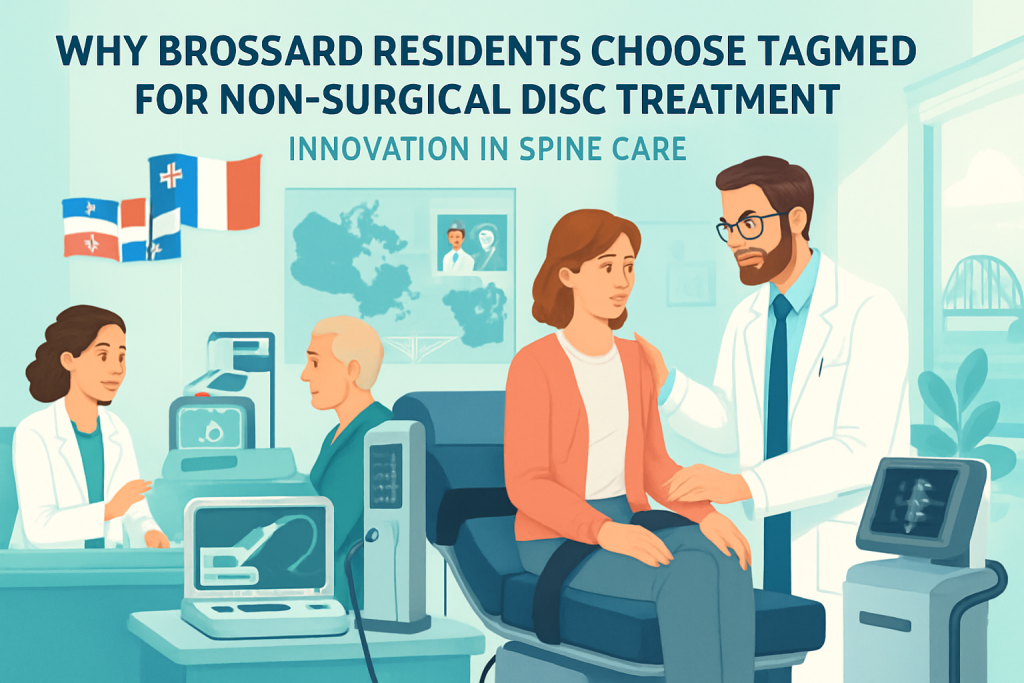
Why Brossard Residents Choose TAGMED for Non-Surgical Disc Treatment
In the vibrant community of Brossard, where wellness and quality of life are paramount, residents increasingly turn to TAGMED for effective management of spinal issues without resorting to surgery. Back pain caused by herniated discs and other spinal disorders can…
Experience and Expertise of Dr. Sylvain Desforges in Spinal Care and Non-Surgical Decompression
In the specialized field of spinal health, the role of a seasoned expert cannot be overstated. Dr. Sylvain Desforges has cultivated over three decades of clinical proficiency, pioneering non-surgical spinal decompression techniques that have transformed patient outcomes in Montreal and internationally.
His formal qualifications, including B.Sc., D.O., and N.D., complement extensive practical ventures, reflecting a holistic and scientific approach to spinal disorders. As founder and president of notable institutions – namely the Alliance Canadienne de Médecine Alternative (ACMA), the Canadian College of Osteopaths, and the TAGMED Clinics – Dr. Desforges advocates for ethical, patient-centered care grounded in sound scientific evidence.
One defining feature of Dr. Desforges’ practice is his commitment to transparent, accessible patient education. His articles on SOS Herniated Disc demystify complex spinal conditions and treatment options, empowering patients to make informed decisions aligned with their individual health status.
His expertise extends beyond local care, efficiently coordinating transatlantic treatment pathways with leading spine surgeons and top-tier clinics in France. This global collaboration ensures access to innovative surgical techniques and sophisticated dynamic spinal implants unavailable in Canada, all while maintaining strict adherence to Quebec and Canadian medical regulations.
- Extensive clinical experience exceeding 30 years
- Founder and leader of multiple professional spine care organizations
- Innovative application of neurovertebral decompression and laser therapies
- Strict ethical compliance prioritizing patient safety and scientific rigor
- Personalized patient evaluation and comprehensive support
Patients seeking leading-edge, personalized spinal care in Montreal can consult with Dr. Desforges at the NDS Spinal Center and ChiroMontreal, where his expertise integrates seamlessly with multidisciplinary teams and state-of-the-art technology.
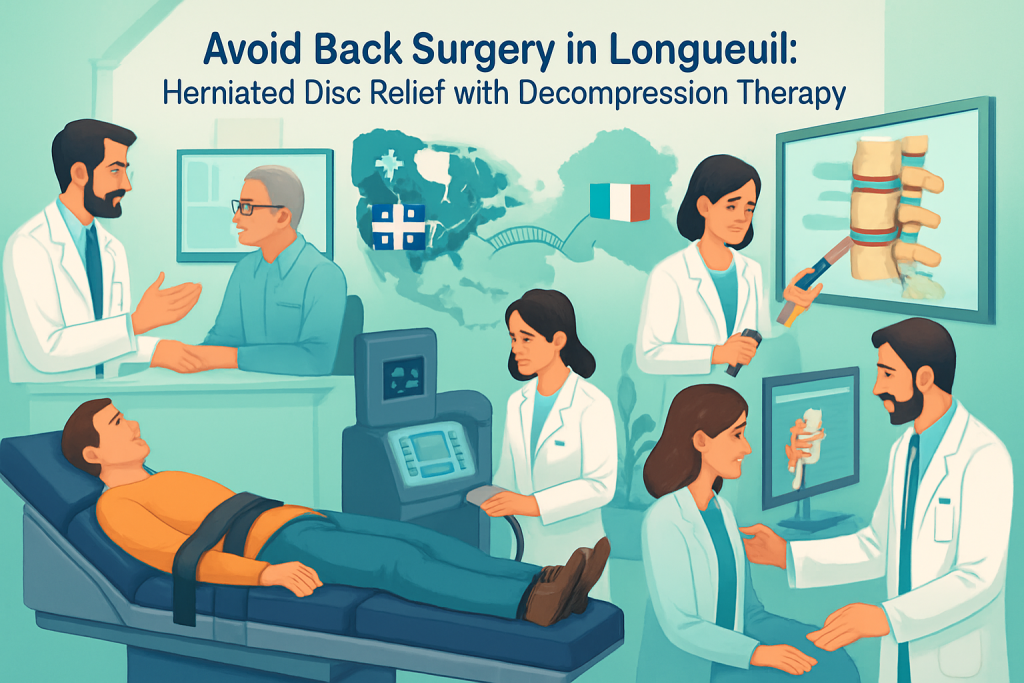
Avoid Back Surgery in Longueuil: Herniated Disc Relief with Decompression Therapy
Residents of Longueuil suffering from persistent back pain often face the daunting prospect of undergoing spinal surgery, which, while sometimes necessary, carries risks and extended recovery times. In recent years, innovative treatments such as nonsurgical spinal decompression therapy have gained…
Comparing Non-Surgical and Surgical Spinal Decompression: Understanding Your Treatment Options
When confronting a herniated disc, understanding the differences between non-surgical and surgical spinal decompression is vital to choosing the best path for recovery. Each approach serves specific patient needs, carries distinct risks, and offers different recovery trajectories.
Non-Surgical Spinal Decompression is best suited for patients with mild to moderate disc herniations where symptoms are manageable and surgery has not yet been prescribed. This approach uses motorized traction devices—such as SpineMed and DRX9000—to gently stretch the spine, reduce intradiscal pressure, and encourage healing without the downtime and risks of surgery.
Surgical Spinal Decompression is generally considered when conservative treatments fail or when severe nerve compression causes significant neurological symptoms such as weakness, numbness, or loss of bowel and bladder control. Surgical options include microdiscectomy, laminectomy, foraminotomy, and corpectomy, each aimed at physically removing pressure from spinal nerves.
| Aspect | Non-Surgical Decompression | Surgical Decompression |
|---|---|---|
| Invasiveness | Non-invasive, no incisions | Invasive, requires incisions and anesthesia |
| Recovery Time | Shorter, typically weeks | Longer, can be months |
| Risks | Minimal, rare discomfort | Higher risk including infection, bleeding, nerve damage |
| Effectiveness | Effective for many mild-moderate cases | Necessary for severe compression or neurological deficits |
| Cost | Generally lower cost | Higher due to hospital and surgical fees |
Resources like WebMD’s detailed comparison and the DEUK Spine blog provide deep dives into these options.
Individual assessment by an expert like Dr. Desforges is essential before deciding on a course, ensuring your care plan reflects your unique presentation and goals.
Illustrating Recovery Expectations with Personal Experience
For example, a patient undergoing non-surgical therapy typically undergoes 20 to 28 sessions over 5 to 7 weeks with each session lasting 30 to 45 minutes. They may also receive adjunct therapies like electrical stimulation or ultrasound to enhance outcomes.
Conversely, surgical patients might face hospital stays, physical therapy lasting up to several months, and possible lifestyle adjustments.

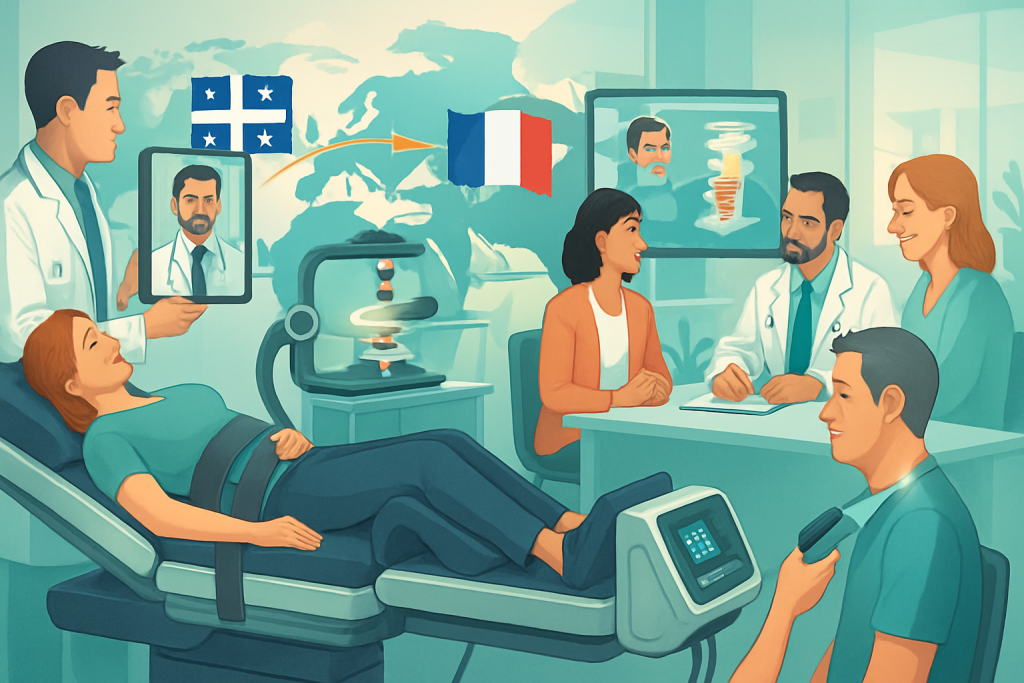
Cervical Herniated Disc Solutions in Terrebonne with Spinal Decompression
In the quest for effective relief from cervical herniated disc symptoms, patients in Terrebonne are increasingly turning their attention to advanced non-invasive treatments. Among these, precise spinal decompression therapy emerges as a beacon of hope, offering a scientifically grounded and…
Preparing for Non-Surgical Spinal Decompression Therapy: Steps to Success
Proper preparation significantly influences the efficacy of non-surgical spinal decompression in treating herniated discs. Patients must actively engage in a multi-step preparation process to optimize treatment benefits.
Initial Specialist Consultation
This involves a comprehensive evaluation of your spinal condition, medical history, and any imaging results. Dr. Desforges employs this to tailor therapy precisely and ensure safety, avoiding contraindications such as fractures, tumors, or advanced osteoporosis (detailed contraindications here).
Pre-Treatment Conditioning
Physical preparation includes strengthening core muscles and improving spinal flexibility through targeted exercises such as pelvic tilts, cat-camel stretches, and gentle aerobic activities. Pre-conditioning improves therapy tolerance and cellular response during treatment.
- Core strengthening: Planks, bridges
- Spinal mobility: Cat-camel stretches
- Low-impact cardio: Walking, swimming
- Stretching hamstrings and lower back
Setting Patient Expectations
Patients are advised on realistic results, recognizing that decompression improves symptoms gradually and adherence is critical to success. Treatment plans usually incorporate additional modalities such as laser therapy or osteopathic manipulation for comprehensive relief.
Dr. Desforges’ emphasis on clear communication and ethical considerations ensures patients understand both the promise and limitations of spinal decompression (learn more here).
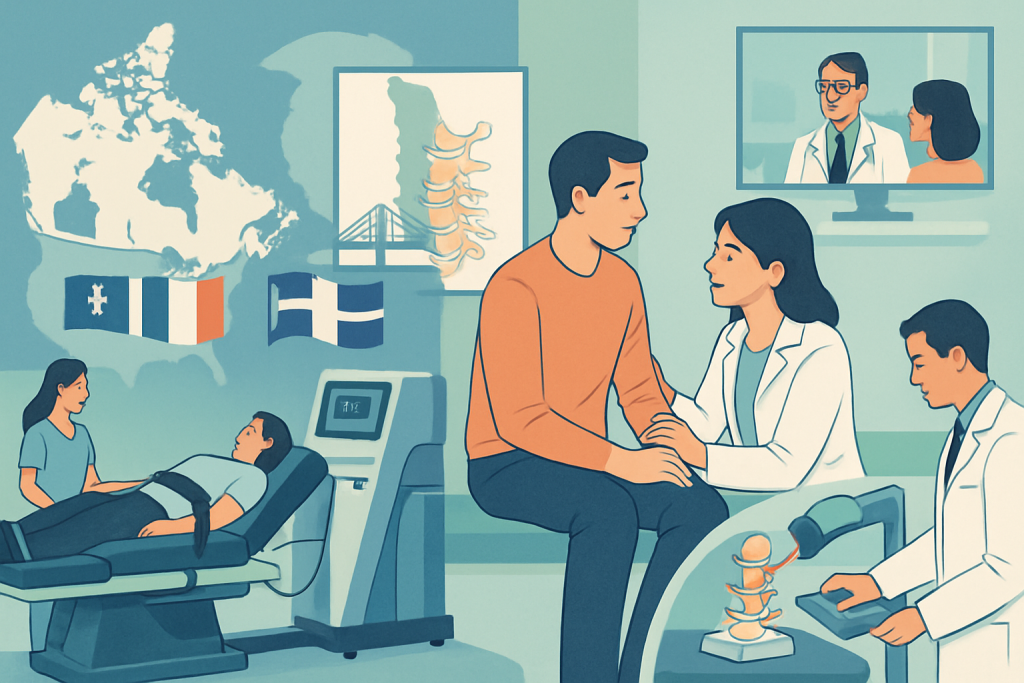
How TAGMED Treats Lumbar Disc Herniations Without Surgery in Laval
Living with a lumbar disc herniation often means navigating through persistent pain, limited mobility, and the fear of invasive surgery. Yet, the modern landscape of spine care is rapidly evolving, offering fresh hope for those seeking non-surgical relief. TAGMED Clinic,…
Post-Therapy Care and Recovery Strategies to Optimize Long-Term Outcomes
Success with spinal decompression extends beyond treatment sessions into carefully managed recovery protocols. Patients benefit immensely from post-therapy recommendations that promote healing, prevent relapse, and enhance spinal functionality.
Immediate Post-Treatment Guidelines
- Rest and avoid strenuous activities for 24-48 hours
- Apply ice packs to reduce inflammation and discomfort
- Stay well-hydrated and maintain nutritious diet
- Avoid heavy lifting or twisting motions during recovery
Long-Term Rehabilitation
Implementing a structured exercise regimen focused on flexibility, strength, and posture correction is vital. Engaging a qualified physical therapist, like those affiliated with Canadian Spine Institute, provides personalized treatment plans.
Regular follow-up appointments track progress, and adjustments are made as needed. Lifestyle adjustments, including proper ergonomic setups at work and home, are recommended to protect spinal health over the years.
| Post-Therapy Aspect | Recommended Actions | Expected Benefits |
|---|---|---|
| Physical Activity | Low-impact exercises such as walking, swimming, yoga | Builds spinal muscle strength, improves mobility |
| Follow-Up Visits | Scheduled appointments with spinal care experts | Monitors healing, tailors further care |
| Lifestyle Modifications | Ergonomic workplace adjustments | Reduces recurrent strain and injury |
The longitudinal approach championed by Dr. Desforges and institutions like NDS Spinal Center integrates these post-therapy necessities into safe, structured recovery paths, increasing the likelihood of lasting relief.


Ask The Doc – Spinal Decompression Therapy and Help for Disc Herniations
The growing prevalence of spinal disorders has ushered in a new era of innovative therapies aimed at alleviating chronic pain and improving patients’ quality of life. Among these, spinal decompression therapy has emerged as a promising non-surgical solution for those…
Physical Therapy and Rehabilitation’s Role in Herniated Disc Treatment and Recovery
Physical therapy is a cornerstone to ensure the benefits of spinal decompression are fully realized following treatment for herniated discs. Tailored exercises and manual therapy help restore spinal stability, reduce pain, and improve patients’ quality of life.
Benefits of Physical Therapy
- Strengthens core and spinal muscles to support vertebrae
- Improves spinal flexibility and range of motion
- Teaches safe movement patterns to reduce re-injury risk
- Decreases inflammation and improves pain management
- Facilitates gradual return to daily activities and work
Recommended Rehabilitation Exercises
- Pelvic Tilts: Strengthen lower back and abdominal muscles.
- Knee-to-Chest Stretches: Increase spinal flexibility and relieve tension.
- Partial Crunches: Build core strength without straining the spine.
- Hamstring Stretches: Enhance posterior thigh flexibility, reducing spinal strain.
- Wall Sits: Strengthen lower body to aid spine support.
Choosing a qualified physical therapist is crucial. Patients should seek professionals with documented experience in spine rehabilitation and who provide personalized care plans for optimal recovery. Clinics such as ChiroMontreal and experts recommended by Inspine Chiropractic & Wellness exemplify best practice in this domain.
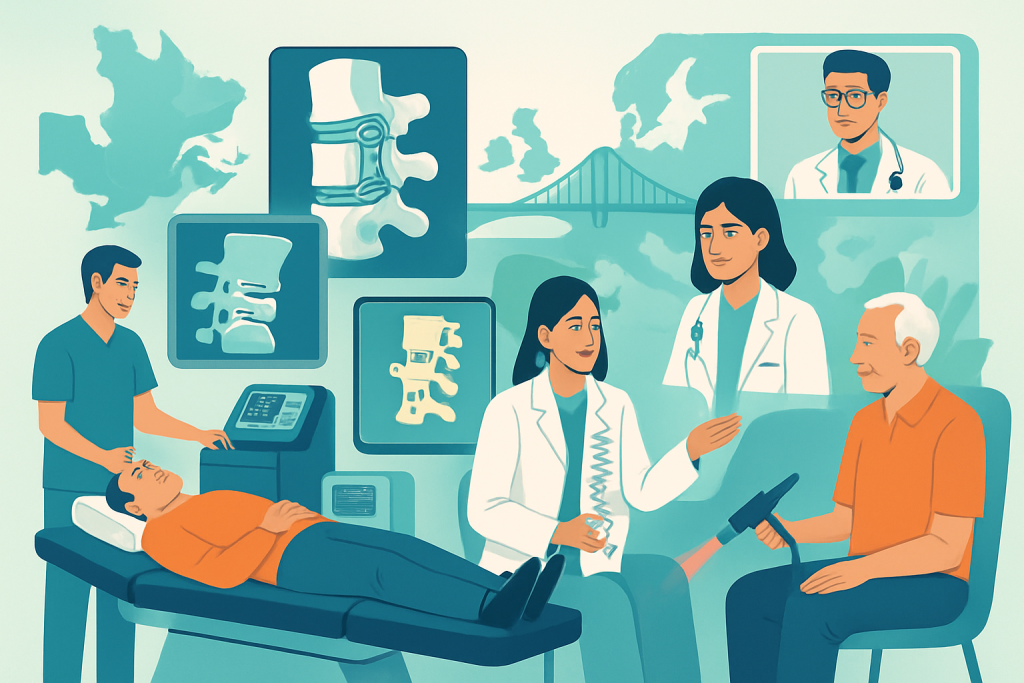
How to Fix a Bulging Disc (NO SURGERY!)
Back pain is a widespread challenge that disrupts millions of lives, often stemming from underlying spinal issues such as bulging discs. These discs, which act as cushions between your vertebrae, occasionally shift out of their normal alignment, causing discomfort and…
Medications and Nutritional Support to Enhance Healing and Manage Pain
While non-surgical therapies focus on mechanical relief, medications and nutrition play vital supporting roles in managing symptoms and fostering spinal health.
Common Medications for Herniated Disc Pain Relief
| Medication Type | Example Drugs | Primary Function | Potential Side Effects |
|---|---|---|---|
| Anti-inflammatory | Ibuprofen, Naproxen | Reduce inflammation and pain | Gastrointestinal upset, increased cardiovascular risk |
| Nerve Pain Modulators | Gabapentin, Pregabalin | Manage nerve-related pain | Dizziness, fatigue, swelling |
| Opioids | Morphine, Oxycodone | Severe pain control | Addiction, nausea, constipation |
Given risks and side effects, Dr. Desforges advises using medications judiciously, complementing them with therapeutic care and lifestyle strategies (learn about nutrition and decompression synergy).
Dietary Recommendations
- Incorporate anti-inflammatory foods rich in omega-3 fatty acids like salmon, walnuts, and chia seeds.
- Eat a variety of fruits and vegetables such as spinach, kale, blueberries, and strawberries.
- Use natural spices like turmeric and ginger known for their anti-inflammatory properties.
- Ensure adequate intake of calcium, vitamin D, and magnesium to support bone and muscle health.
Such nutritional habits bolster tissue repair, decrease inflammation, and improve overall spinal strength, aligning with the holistic care model advocated by Dr. Desforges at Clinique TAGMED and other centers in Montreal.
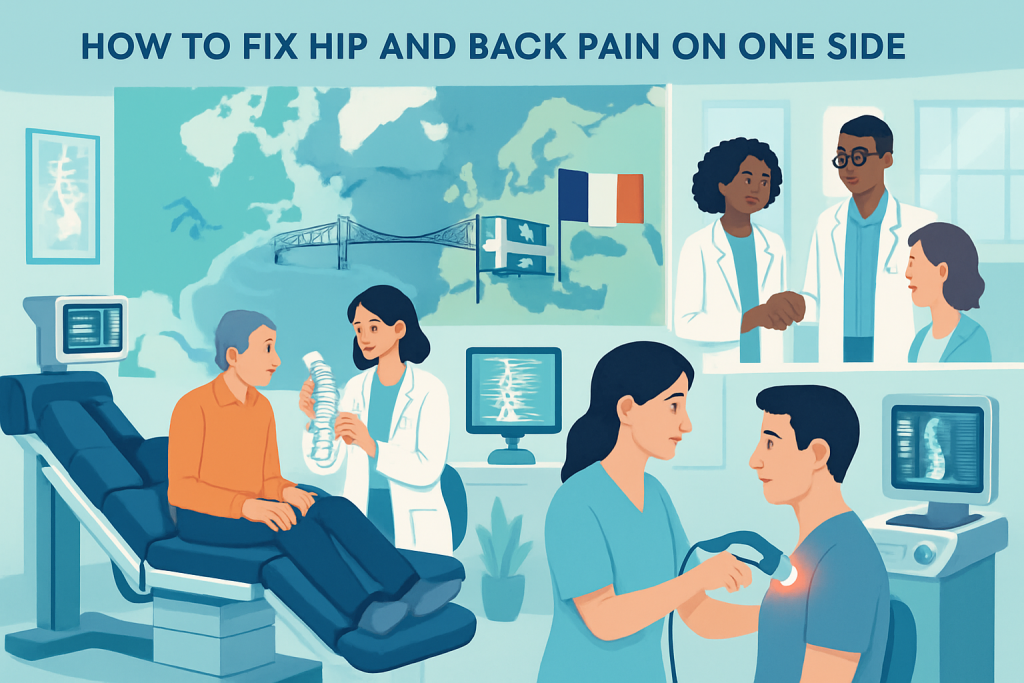
How to Fix Hip and Back Pain on One Side
Experiencing persistent pain on one side of the hip and lower back can be debilitating, restricting not only movement but also the enjoyment of daily activities. Such discomfort often signals specific underlying issues requiring targeted attention. In 2025, advances in…
International Collaboration and Patient Care Journey Coordination from Montreal
One of the distinguishing features of Dr. Sylvain Desforges’ practice is his active role in orchestrating an integrated care pathway spanning Canada and France. This transatlantic coordination expands access to advanced treatment options and novel technologies for Montreal patients with complex spinal conditions.
Through partnerships with elite spine surgeons and clinics in France, facilitated by networks such as SOS Tourisme Médical, Dr. Desforges ensures seamless scheduling, expert consultations, and continuity of care before, during, and after specialized interventions.
- Access to innovative surgical techniques and dynamic spinal implants unavailable locally
- Optimized treatment timelines, minimizing typical delays
- Individualized case management addressing both medical and logistical factors
- Multilingual patient support and cultural sensitivity in care delivery
This network exemplifies a patient-first philosophy, combining Dr. Desforges’ rigor with international collaboration to deliver the highest standards of care. Patients can expect comprehensive support throughout their journey, whether opting for advanced surgical options abroad or state-of-the-art non-surgical therapies in Montreal.
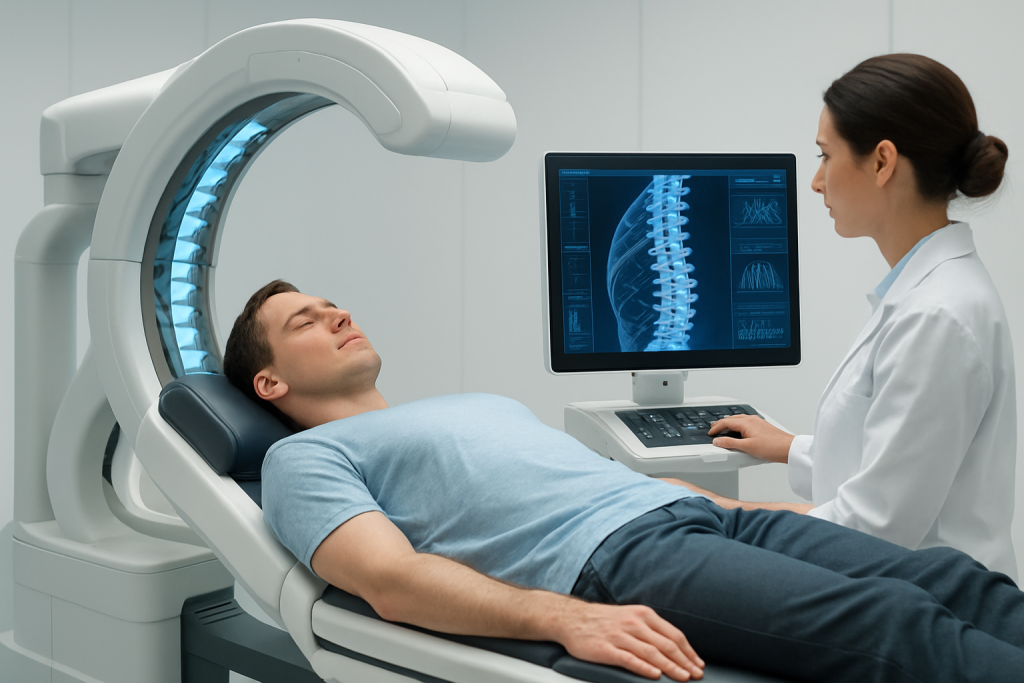
Can Cousin Spine technology help us avoid surgery?
The evolving landscape of spinal care in 2025 introduces a dynamic blend of innovation, technology, and patient-centric solutions aimed at reducing the reliance on traditional spinal surgeries. Among pioneering developments, Cousin Spine technology stands out by offering novel approaches that…
Clear FAQs About Non-Surgical Spinal Decompression Therapy and Herniated Discs
What exactly is a herniated disc, and how does it cause pain?
A herniated disc occurs when the gel-like center of a spinal disc protrudes through a tear in the outer layer. This can press on nearby nerves, causing symptoms like pain, numbness, tingling, or muscle weakness, depending on the affected region. The resulting nerve compression often leads to back pain and discomfort radiating to limbs.
Who is an ideal candidate for non-surgical spinal decompression therapy?
Ideal candidates are patients with mild to moderate herniated discs who have not responded fully to conservative treatments like physical therapy or anti-inflammatory medications. Individuals with contraindications such as spinal fractures, tumors, advanced osteoporosis, or pregnancy should avoid this therapy. A comprehensive evaluation by an expert such as Dr. Desforges ensures safe, tailored recommendations (more details).
How many treatments are typically required, and what is the recovery process?
Patients commonly undergo 20 to 28 treatment sessions over a 5 to 7 week period, with each session lasting about 30 to 45 minutes. Recovery involves immediate post-therapy rest, followed by physical rehabilitation and lifestyle modifications to maintain spinal health. Ongoing follow-up with healthcare providers facilitates optimal results.
Can spinal decompression therapy completely eliminate the need for surgery?
While non-surgical decompression can significantly reduce pain and improve function for many, some severe cases may still require surgical intervention. The goal is to exhaust effective conservative options first, minimizing invasive procedures. Dr. Desforges’ thorough evaluations assist in determining the best approach for each patient.
Is the therapy painful or uncomfortable during sessions?
Most patients report feeling comfortable during non-surgical spinal decompression sessions, as the stretching is gentle and computer-regulated. Some may experience mild discomfort initially, which typically subsides as treatments progress. Ensuring treatment customization enhances patient comfort and efficacy.

